Dome Sweet Dome
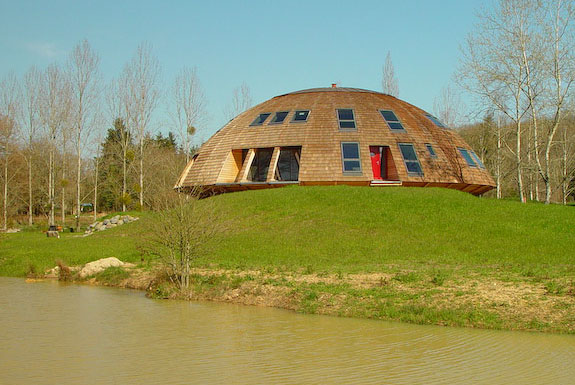
SPOT MORE COOL STUFF:
Architecture | 26 Comments
| All Design Reviews
Visit a Harmonique Domespace house and you’ll instantly take note of its sleek, curved exterior and the wood-laden interior filled with skylights and dramatic ceilingscapes. But here are some things you won’t notice, at least not right away:
• The entire house rotates! The rotation is so smooth and gradual as to be imperceptible from both inside and outside the house (imagine trying to see the movement of an hour hand on a watch). The dome owner can direct the house to point in a particular direction by use of a remote control. But primary purpose of the rotation is to make optimal use of the solar panels that line the roof of the Domespace and the passive solar properties of the house’s many windows. Which brings us to . . .
• Extreme energy efficiency. The solar panels produces most, if not all, of the energy required to power life in a Domespace house (during the day, at least, when the sun is shining). It helps that a Domespace is more electricity efficient than a typical house. A dome naturally has greater thermal efficiency. And the Domespace’s many skylights virtually eliminate the need of electric lights during the day.
• Increased safety. The dome’s naturally aerodynamic shape, along with Domespace’s solid construction, allows this house to withstand winds up to 175 mph (281 km/h) without sustaining significant damage. That’s a category 5 hurricane! The Domespace can also withstand an earthquake up to an 8 on the Richter Scale. How impressive is that? An 8 Richter Scale earthquake is equivalent to a 1 gigaton TNT bomb and would be tied for the 6th strongest ever recorded. (We aren’t sure what would happen if the Domespace were simultaneously hit by a massive earthquake and hurricane but at that point the rapture might be nigh giving you have bigger things to worry about).
• Quick construction. The Domespace’s design incorporates many prefabricated elements allowing for relatively short built time. The complete exterior of an average size Domespace can be built in a mere three months!
Domespace offers their Harmonique rotating dome houses in a variety of sizes; the larger ones have two living levels. Each Harmonique model is also available in a non-rotating Eclosion version, which isn’t as cool but does make the location of the front door more predictable.
Domespace also makes a miniature non-rotating dome called the Transit. The one-room Transit domes are intended for guest quarters or vacation properties. At the other end of the scale, the company constructs built-to-spec Emergence domes that are large enough to function as churches, hotels and municipal buildings.
No matter the model and size, for a cool-looking energy efficient house there truly is no place like dome.
DOMESPACE (IN EUROPE, FRENCH INFO) | SOLALEYA (U.S.A., ENGLISH INFO) |
Related posts:
7 Incredible Upside-Down Buildings
5 Cool Structures Made of Shipping Containers
An Odd Medical-Theme Restaurant
The World’s Only Pub That’s Inside A Tree
The Best Designed Travel Mouse
Transit 4,35
Radius: 14.2 ft (4.35m) | Ceiling Height: 11 ft (3.3m) | Area: 420 sq. feet | Levels: 1
Harmonique 5,38
Radius: 17.6 ft (5.38m) | Ceiling Height: 11 ft (3.3m) | Area: 656 sq. feet | Levels: 1
Harmonique 6,65
Radius: 21.8 ft (6.65m) | Ceiling Height: 13.5 ft (4.1m) | Area: 1,485 sq. feet | Levels: 2
Harmonique 7,63
Radius: 25.1 ft (7.63m) | Ceiling Height: 15.5 ft (4.7m) | Area: 2,109sq. feet | Levels: 2
Eclosion 7,63 (doesn’t rotate)
Radius: 25.1 ft (76.3m) | Ceiling Height: 15.5 ft (4.7m) | Area: 2,109sq. feet | Levels: 2
Harmonique 8,71
Radius: 28.5 ft (8.71m) | Ceiling Height: 17.5 ft (5.3m) | Area: 3,024sq. feet | Levels: 2
Harmonique 11,65
Radius: 38.2 ft (11.65m) | Ceiling Height: 23.5 ft (7.1m) | Area: 5,640sq. feet | Levels: 2
Emergence
DOMESPACE (FRANCE) | SOLALEYA (U.S.A.) | FOLLOW US ON TWITTER
Related posts & pages:
Unusual Architecture: Upside-Down Buildings
The Best Websites For Home Remodeling & Redecoration
8 Amazing Alternative Motorcycles
5 Cool Shipping Container Buildings
Cool Architecture
Yurts So Good
The Cave House For Sale On eBay
Museumotel
Would you like to live in a dome? Make yourself at home in our comments section:












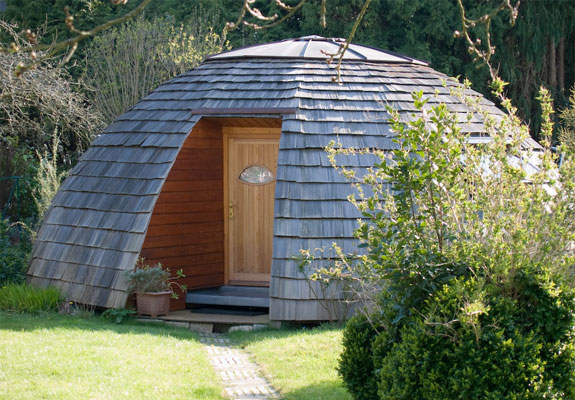
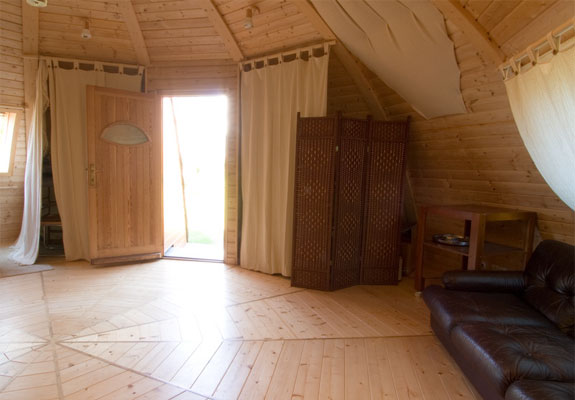
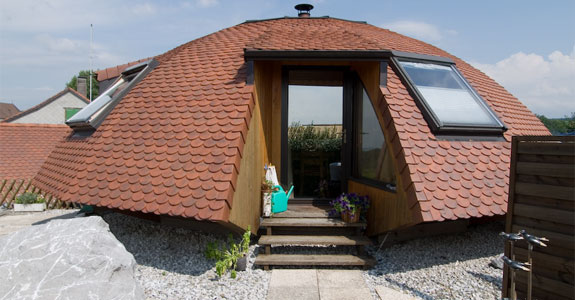
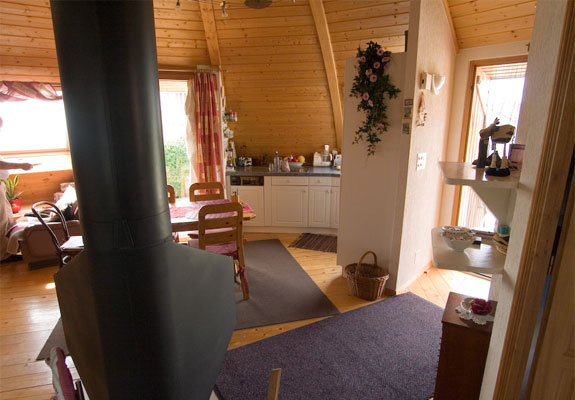

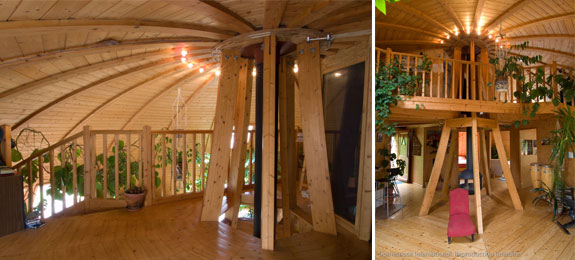
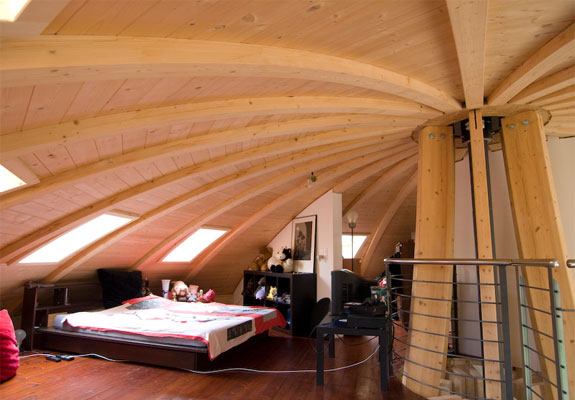
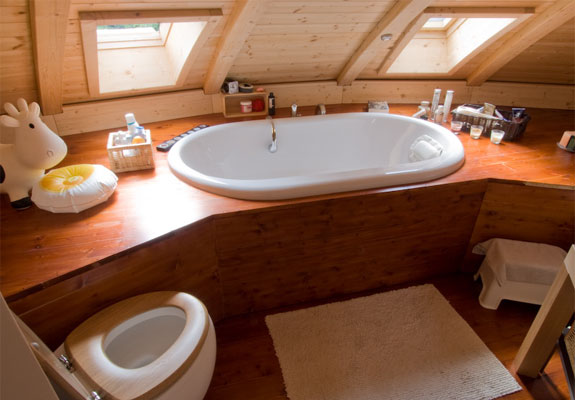
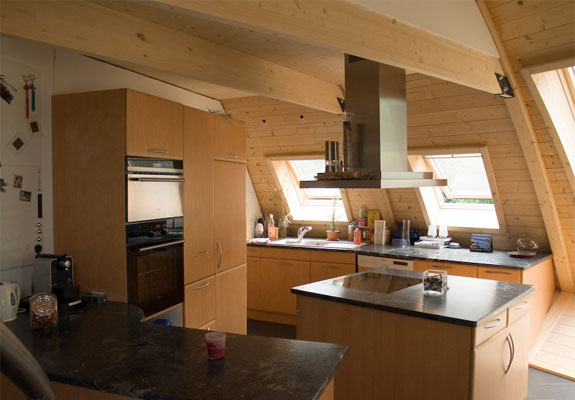
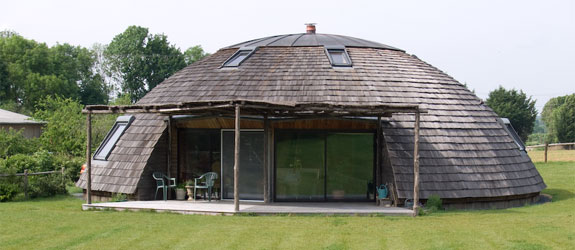

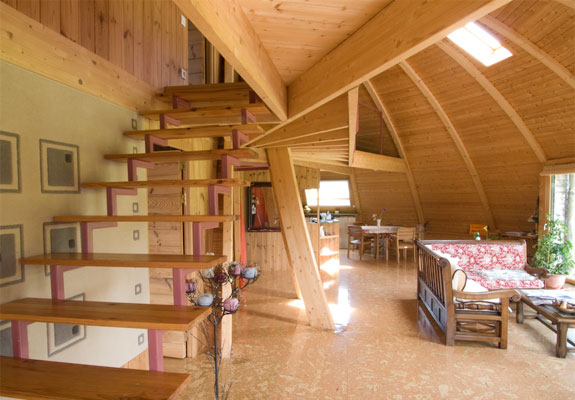
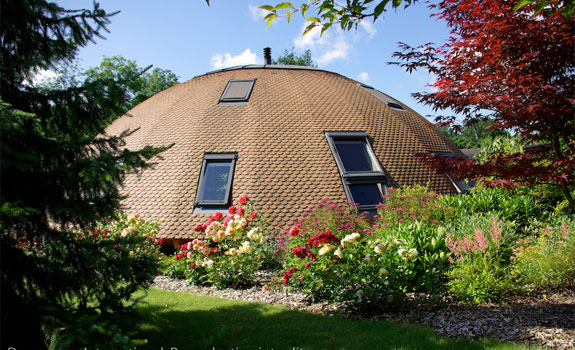
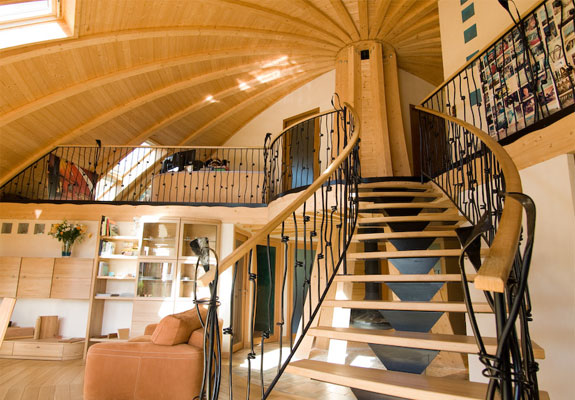


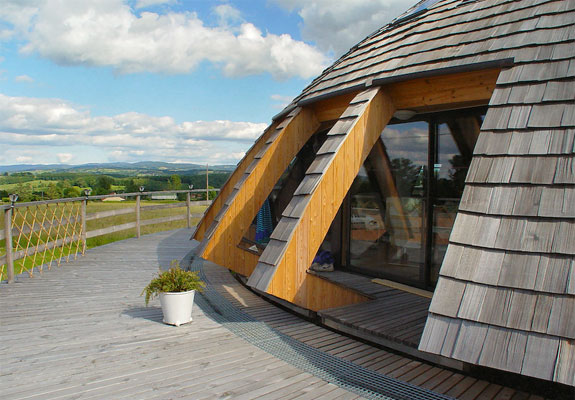
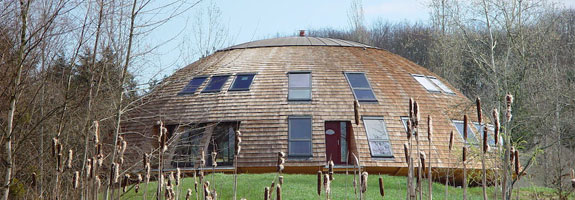
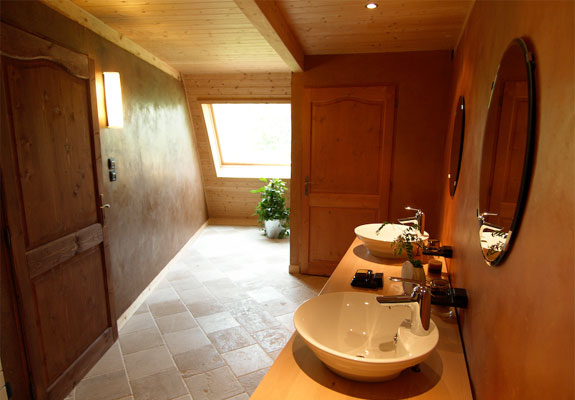
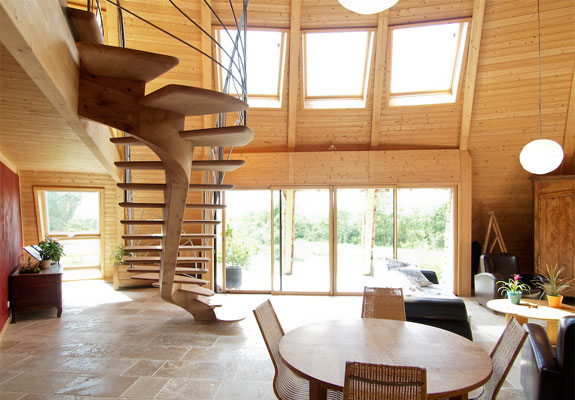








August 3rd, 2011at 10:51 am(#)
wow its actually not that expensive then!
ive been to houses that are well over that and none of them look this nice
also love that theres different sized models!
[Reply to this comment]
March 23rd, 2011at 11:31 pm(#)
nice idea
[Reply to this comment]
March 28th, 2010at 12:54 pm(#)
Perfect domesticity
[Reply to this comment]
October 9th, 2009at 5:37 am(#)
Husband and I have land and Colorado. We sent for floor plans to build a dome house. We talked of building one that turns. How do we obtain floor plans for this? Is it possible to have a basement with this. I have seen those moving skyscrapers that use wind as well as solar.Looking forward to this info! Are they very expensive to build?
[Reply to this comment]
April 6th, 2009at 2:21 pm(#)
where are you lcoated? Are the costs you mentioned before transportation to sight?
[Reply to this comment]
Spot Cool Stuff Reply:
April 7th, 2009 at 1:08 pm
Steve:
We don’t sell these houses. We report on them.
The dome home company that deals with the North American market, Solaleya, is outside of New York City; they have a sample house there you can tour.
In Europe the company is called Domespace and is located in Quimper, in northeastern France about an hour’s drive south of Brest. The public is welcome at their showroom too.
You’ll find links to both companies after the house photos, above.
[Reply to this comment]
March 29th, 2009at 12:40 pm(#)
The 1st one that says the “primary” reason for rotating the entire house is to align the solar panels. This a load of crap.. You want to talk efficient? Efficient is a still house and you just rotate the solar panels them self.. Duh? Now for the truth.
Well, the truth is, it’s likely the rotating house intended to be a bit exotic and not having to rotate the panels separately is simple a bonus.
Funny: Saying the house rotates to move the solar panels is like the age old joke.. How many ______ does it take to screw in a light bulb, 1 to hold the light bulb and 100 to spin the room. ( Or any other variant. ) If this guy turns an entire house to aim a set of solar panels It’d make me wonder about the architects intelligence. As well as , it gives me a real life pawn for the joke.
[Reply to this comment]
Spot Cool Stuff Reply:
March 30th, 2009 at 12:16 pm
One of the unexpected things from running this site is learning of how many angry and hating people there online. Spot Cool Stuff is a fun, non-political site. You wouldn’t believe how many ranting, angry comments we get. (One commented even used an ugly racist slur to describe the people who must live in a dome house). Why? Why instead of simply making your point in a respectful way or simply stating your question do you have to call our work a “big load of crap,” and imply that we are stupid and/or covering up the truth? I don’t get it.
To the substance of your point:
Undoubtedly, the rotating aspect of the dome house is partly to add WOW factor. The actual rotating doesn’t take much power—the electricity needed to turn the house 360 degrees is about the same as it takes to vacuum the house once.
The thing I think this commenter, friendly as he is, missed is that the house has active and (like almost all other houses) passive solar properties. The active is the solar panels. The passive is the light that comes through the windows. It is on the basis of the passive benefits that the house rotates.
So, on cold days the house will point whatever part of it has the most windows towards the sun; as the sun moves so will the house. On hot days, the opposite. On days when you aren’t heating or cooling the house the dome will rotate to allow for the most sunlight inside those rooms of the house you are most likely to be using (thus reducing the need to turn on lights). And that’s how rotating aspect of the house creates efficiency.
[Reply to this comment]
March 28th, 2009at 1:37 pm(#)
“We aren’t sure what would happen if the Domespace were simultaneously hit by a massive earthquake and hurricane but at that point the rapture might be nigh giving you have bigger things to worry about”….i like that:)…i used to weld 60 ton shelters to concrete slabs…same applies there too…looks good…now if there were more of these in the world maybe everyone would relax a little easier.
[Reply to this comment]
March 23rd, 2009at 8:27 pm(#)
I still don’t understand the utility solution. Obviously it works, but I don’t understand how a fixed column helps bring water into the home when it is constantly rotating, as the faucets are on the move. Is there some kind of bearing system?
Is there any way to just purchase the rotating system for a self built home?
[Reply to this comment]
March 21st, 2009at 3:10 pm(#)
omggg where can i get one of theseee???
[Reply to this comment]
March 20th, 2009at 5:14 am(#)
Wow, I want one too!
thekeybunch’s last blog post..Designer Spotlight: Chetana Sharma
[Reply to this comment]
March 19th, 2009at 6:33 pm(#)
wow, those are amazing, I never knew
sir jorge’s last blog post..Soldiers in the Army of God Review
[Reply to this comment]
March 19th, 2009at 12:47 pm(#)
I have seen these homes a few times and besides the fact that placing furniture is an issue this is a great house and very energy efficient.
Holly’s last blog post..Get Environmental With Felt
[Reply to this comment]
March 19th, 2009at 6:07 am(#)
Nick:
The utilities do go through the center column. The column is actually shaped more like a tall triangle, thin at the top and a little thicker towards the bottom. This leaves enough space to run all the plumbing, et al out the bottom of the house. From there, the utility pipes are usually buried underground, the same as for most normal houses.
Thomas:
If we gave out points or prizes for comments you would win lots for catching the decimal error on the radius measurements. They are fixed now. Thanks!
As for storing the solar, there are ways to do that but it is inefficient and expensive. Most solar houses (domed or otherwise) are hooked into the grid. When the house produces more electricity than it uses it sells electricity INTO the grid — the house’s electricity meter literally runs backwards. If the house needs more electricity it automatically takes it from the grid.
How much solar electricity is produced and whether it can run an entire house depends on several factors, the house’s location, type of solar cells and the house’s energy consumption key among them. Running air conditioners and clothes dryers are extremely energy intensive–most (though not all)solar houses can not produce enough electricity to run both at once. However, most solar houses also produce more than enough electricity to power lights, a fridge, a computer and a few other basic needs during the day.
Erica:
The cost depends on the size of the dome, where it is being built and other factors. In the USA, for the 7.63 model (photos, above), the materials cost US$141,000 for a non-rotating dome and $189k for the rotating. Then there’s the build-out price, which is $120k for that size. Plus, of course, you need to buy the land to place the house.
[Reply to this comment]
March 18th, 2009at 9:31 pm(#)
what is the cost of a dome home?
[Reply to this comment]
March 18th, 2009at 9:10 pm(#)
I would only want one door, it’d be neat not knowing where I would exit at any given time.
[Reply to this comment]
March 18th, 2009at 9:00 pm(#)
Quick question. I love the domes. However, what is up with the radius measurements? On the first one it says that the dome is 870 m across in diameter, or 435 for radius. That is the length around a track twice. And the last dome projects a radius of 1165 m, however the ceiling is only 23.5 feet. That simply doesn’t make a whole lot of sense. Just saying?
Aside from that, this makes an intriguing home. Does the electricity become stored? How much can solar power truly power a house with computers and sound systems, let alone air conditioning. It would be an interesting step towards the right direction, but has a few kinks to work out.
let me know if I’m completely wrong.
[Reply to this comment]
March 18th, 2009at 5:33 pm(#)
How do you connect to external utilities? Gas, electricity, water, sewage etc? I can see that by routing everything to the central column you can solve the problems internally but the connection to the outside world must be a major difficulty. Especially with varying building regulations in different countries.
[Reply to this comment]
March 18th, 2009at 12:56 pm(#)
It would have been great if homes also rotated… always on the sunny side.
[Reply to this comment]
March 18th, 2009at 12:46 pm(#)
A few people have been emailing us questions about the dome homes. It is better for everyone if questions are left in the comments section instead.
The two most common questions, one of which Markus just asked:
Doesn’t it waste electricity to rotate the entire house?
No. The the power required to move the house through one full rotation is about the same as it would take to vacuum the house once. Rotating an object on a point is very efficient. What you gain in the passive and active solar power by pointing the house towards the run more than makes up for what’s lost in the rotating itself.
What about the front door?
This is more of an issue. There are two basic ways to solve it:
1) Have the dome on a perfectly flat piece of land. Or build a flat deck (see the photo under the Harmonique 8,71 set).
2) Have multiple doors, so that one is always more or less at the “front” of the house. This is what the people did who live in the dome house at the very top of this article.
[Reply to this comment]
March 18th, 2009at 12:39 pm(#)
You talk about how power efficient the dome is. Isn’t it a waste of power to be rotating the dome around? That must take a tremendous amount of electricity. I’m just saying.
As always, you have very cool, well written, articles. Thanks.
[Reply to this comment]
March 17th, 2009at 12:33 pm(#)
sign me up!
[Reply to this comment]
March 17th, 2009at 10:36 am(#)
pretty cool if you ask me…i want one too.
[Reply to this comment]
March 17th, 2009at 9:27 am(#)
Me too!
[Reply to this comment]
March 17th, 2009at 12:47 am(#)
I want one!
[Reply to this comment]